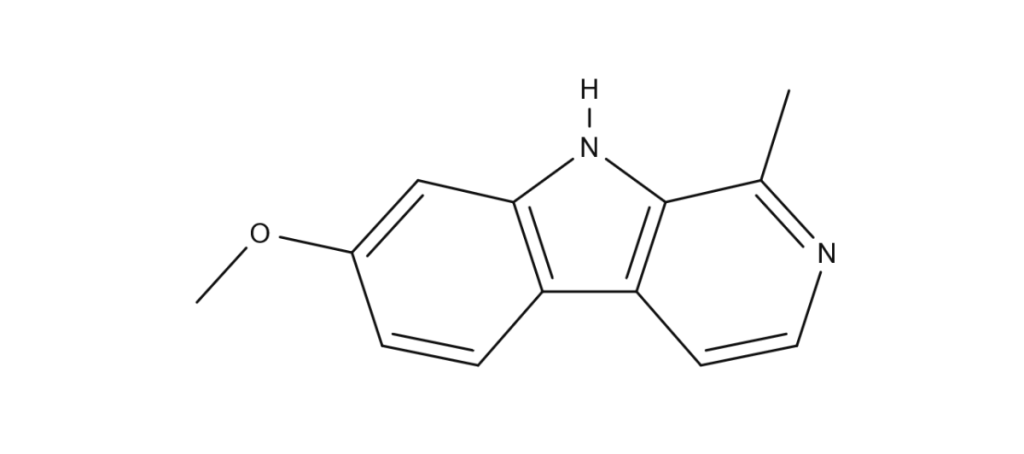Deep in the jungle, a man is stripping the bark of a thick, climbing vine. An old pot boils over open fire and the steam hangs low in the humid rainforest. He is preparing for a sacred ceremony.
| Plant Classification | |
| Order: | Malpighiales |
| Common Name: | Ayahuasca vine |
| Family: | Malpighiaceae |
| Genus: | Banisteriopsis |
| Species: | Banisteriopsis caapi |
This vine is called Banisteriopsis caapi and it belongs to the plant family Malpighiaceae. Among the people familiar with it, it is a plant of many names. Some of these names include Caapi, Yaje, Vine of the Dead, and Vine of the Soul (Cleversly 2013). You may be most familiar with this vine from its role in ayahuasca- a brew containing B. caapi and the leaves of another plant called Psychotria viridis.

Above: Ayahuasca being brewed from Banisteriopsis caapi vine and Psychotria viridis leaves. Image by: Awkipuma (Wikipedia Commons)
In the Amazon rainforest, shamans (traditional healers, medicinemen/women) are sacred to tribal cultures. Shamans provide both physical and spiritual healing to people by concocting and administering medicine to sick people in the forms of plants available to them in nature (Jauregui et al. 2015). Shamans may also summon specific spirits from the spirit world that they believe will help heal a sick person. Treatments are catered to the person and situation. But how does one become such a mysterious and magical figure? Shamanic initiations take years and are physically, mentally, emotionally, and spiritually taxing (Jauregui et al. 2015). Initiations consist of retreating to the forest, away from all communication, and ingesting hundreds of biologically and psychologically active plants in order to get to know each one for future use in healing others (Jauregui et al. 2015). For another example of an interesting shamanic ritual from this area, check out this video. Many plants will be ingested over the course of a shaman’s initiation and practice, but none are more important than Banisteriopsis caapi.

Above: Structure of harmine molecule found in Banisteriopsis caapi
Chemicals of interest
Banisteriopsis caapi contains chemicals called MAOI inhibitors. MAOI inhibitors, as their name would suggest, inhibit an enzyme in the brain called monoamine oxidase(Ogbru 2015). Monoamine oxidase breaks down norepinephrine, serotonin, and dopamine (Ogbru 2015). These are what you’d call “happy chemicals”. When these chemicals can’t be broken down, they become more concentrated in the brain (Ogbru 2015). For this reason, MAOI inhibitors were the first class of antidepressant drugs to be developed (Ogbru 2015). MAOI inhibitors in B. caapi allow the psychedelic effects of the aforementioned Psychotria viridis plant to become active in the brain without being broken down. This brew is ingested nightly by the shamans-to-be, keeping them in an out-of-body state in order to contact the spirit world and meet the “mothers” of every plant they consume. The MAOI inhibitors found in the bark, trunk, and stem of this vine belong to a chemical class called beta-carboline (harmala) alkaloids. Some of the harmala alkaloids active in B. caapi are harmine, harmaline, and tetrahydroharmine (more detailed info on harmala alkaloids can be found here).

Above: A look inside the vine. Image by: Giorgio Samorini (Flickr)
The magic is in the molecules. These ones just so happen to lend us humble humans a key to the spirit realm and leave those who sip it forever changed. In the case of the shaman, they provide other-worldly wisdom and the ability to heal using natural medicines.
Other uses of Banisteriopsis chemicals
- Reduction of blood pressure
- Anti-anxiety supplements, antidepressants, and mood controllers
- Prophylactic against malaria and other parasites
- Antimicrobial
- Treatment of Parkinson’s and Alzheimer’s disease
(de Frias et al. 2012)
References
Banisteriopsis caapi. Wikipedia. 2016 Aug 22 [accessed 2017 Jan 25]. https://en.wikipedia.org/wiki/Banisteriopsis_caapi
Callaway JC. Phytochemical analyses of Banisteriopsis caapi and Psychotria viridis. Journal of Psychoactive Drugs. 2005;32(2):145–150.
Cleversly K. 2013 Jan 31. Banisteriopsis caapi – Ayahuasca. Entheology.com. [accessed 2017 Jan 18]. http://entheology.com/plants/banisteriopsis-caapi-ayahuasca/
Erowid Banisteriopsis (caapi) Vault. Erowid Banisteriopsis (caapi) Vault. 2016 Feb 5 [accessed 2017 Jan 18]. https://erowid.org/plants/banisteriopsis/banisteriopsis.shtml
Frias D. Banisteriopsis Species: A Source of Bioactive of Potential Medical Application. International Journal of Biotechnology for Wellness Industries. 2012 [accessed 2017 Mar 4].
Harmala alkaloid. PsychonautWiki. 2016 Dec 23 [accessed 2017 Jan 18]. https://psychonautwiki.org/wiki/Harmala_alkaloid
Jauregui X, Clavo Z, Jovel E, Pardo-De-Santayana M. “Plantas con madre”: Plants that teach and guide in the shamanic initiation process in the East-Central Peruvian Amazon. Journal of Ethnopharmacology. 2011 [accessed 2017 Jan 25];134(3):739–752.
Ogbru PDO. Monoamine Oxidase Inhibitors (MAOIs): Side Effects, Dosage. MedicineNet. 2015 Mar 27 [accessed 2017 Feb 9]. http://www.medicinenet.com/mao_inhibitors-oral/article.htm#what_are_monoamine_oxidase_inhibitors_MAOIs
Sanz-Biset J, Cañigueral S. Plant use in the medicinal practices known as “strict diets” in Chazuta valley (Peruvian Amazon). Journal of Ethnopharmacology. 2011 [accessed 2017 Jan 25];137(1):271–288.
Wink M. Ecological Roles of Alkaloids. Modern Alkaloids. 2008 [accessed 2017 Jan 25]:1–24.
Images
Apollo. Ayahuasca Vine. 2015.
Awkipuma. Pagluluto ng Ayahuasca. 2010.
Samorini G. Banisteropsis caapi-2. 2009.








